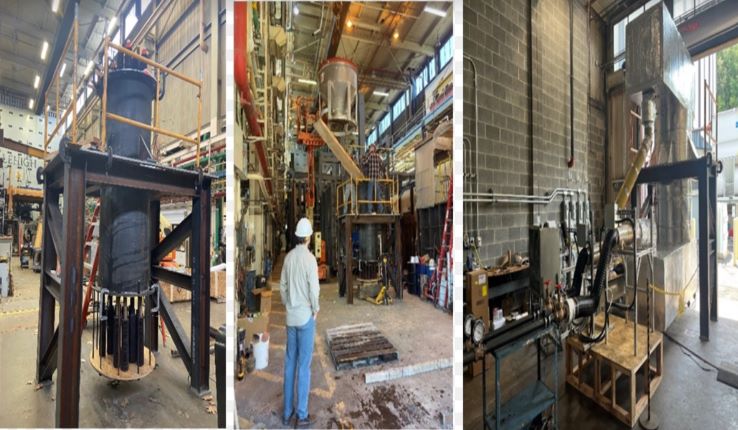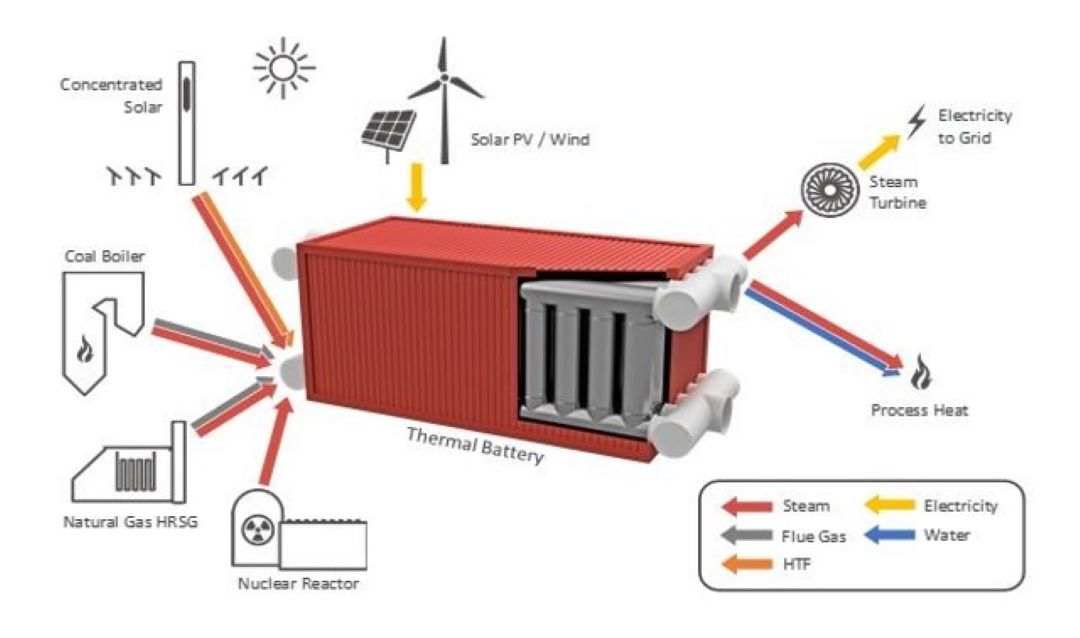Lehigh engineers have engineered, built and tested an innovative thermal energy storage prototype system.
Article Source: Lehigh University
Article Link: https://www2.lehigh.edu/news/engineers-unveil-lehigh-thermal-battery-for-decarbonization-applications
Photo Credit: Shutterstock
In the ramp up to more widespread renewable energy use, thermal energy storage is becoming a go-to solution for enabling power grids to respond to variable supply and demand conditions. When demand is high and solar or wind energy are not available, stored energy could answer the call, and keep the United States moving in a greener direction.
Thermal energy storage systems are like batteries that use temperature shifts to store energy for later use or for use at another location. Such systems capture energy in different ways, and the most commonly used techniques are based on latent and sensible heat transfers. The latent heat method involves using the amount of thermal energy needed for a phase change―which is a change in physical state, such as from solid to liquid, or liquid to gas―without altering a material’s temperature. Sensible heat is the thermal energy required to raise the temperature of a material without causing any phase transitions.
One of the benefits of the latent heat transfer technique is that it enables large amounts of heat to be stored and transferred. In other words, latent heat storage systems are associated with large energy densities. A major advantage of the sensible heat transfer technique is its low cost; however, it relies on large temperature changes to convey large rates of heat transfer.
Now, Lehigh engineers, with support from the Department of Energy, have developed a new thermal energy system, the Lehigh Thermal Battery, which combines the best of both techniques. The technology consists of engineered cementitious materials and thermosiphons in a combination that enables fast and efficient thermal performance at low cost. The technology is capable of operating with heat or electricity as the charging energy input. The team has announced that, after three years of research and development, the technology is scalable and market-ready.
The project is a collaboration between Lehigh’s Energy Research Center, Lehigh’s Advanced Technology for Large Structural Systems (ATLSS) Engineering Research Center and Advanced Cooling Technologies.
“The concrete plus thermosiphon concept is unique and new among heat energy storage concepts,” says Carlos Romero, co-principal investigator on the project and director of the Energy Research Center at Lehigh. “The technology offers the potential for adaptation over a broad range of temperatures, and heat transfer media and operating conditions. This makes it suitable for decarbonization opportunities in industry, the flexibilization of conventional power plants, and advancements and penetration of concentrated solar power.”
“The Lehigh Thermal Battery technology is innovative because it is modular, designed for independent energy input/output streams during charging/discharging which is feasible with the help of the thermosyphons, and the two-phase change process inside the thermosyphon tubes allows rapid isothermal heat transfer to/from the storage media at very high heat transfer coefficients and heat rates,” says Co-Principal Investigator Sudhakar Neti, professor emeritus in the Department of Mechanics and Mechanical Engineering at Lehigh.

The 150-kWhth prototype built at the Energy Research Center is a fully instrumented 5ft ø x 15ft tall structure containing 22 finned thermosyphons. The 150-kWhth prototype has been tested extensively using compressed air at 480°C, producing an energy-to-energy charge/discharge efficiency of the solid media at better than 95%, uniform temperature distribution in the solid media during charging, and consistent cyclic repeatability. The average power rates achieved during charging and discharging were 16.4 and 19.8 kWth, respectively, with a very fast energy gradient of the thermal battery of 0.51 kWhth/min during the first hour of discharge.
In addition to Romero and Neti, team members include: Clay Naito, Spencer Quiel and Muhannad Suleiman, faculty members in the Department of Civil and Environmental Engineering; Zheng Yao, Research Scientist at Lehigh’s Energy Research Center; and, from Advanced Cooling Technologies, a thermal management solutions company in Lancaster, Pennsylvania: Chien-Hua Chen, Devon Jensen, Yue Xiao, and Daksh Adhikari. Additionally, Lehigh graduate students Ahmed Abdulridha, Julio Bravo, Dominic Matrone and Shuoyu Arnold Wang were involved in the project.
The project has just completed a three-year schedule, which included research and development of system components, system design and integration, and integrated system testing at 3, 10 and 150 kWhth in a relevant environment. The 3-kWhth system, consisting of an electrically charged design, was tested at Dominion Energy’s Mount Storm, WV Power Plant, achieving repeatable electrical-to-heat round-trip efficiencies in the mid-70%.
“Lehigh’s thermal energy systems design physically separates the flows of energy into and out of the system,” says Yao. “Charging takes place by allowing a heat transfer fluid or electrical energy at a bottom plenum to activate the evaporator-charging section of the thermosyphons. A two-phase fluid inside the thermosyphons allows for rapid, uniform, and isothermal distribution of heat into the cementitious storage media.”
“The energy storage solid media has been engineered to operate under heavy cycling duty by using a special concrete formulation which maximizes media heat capacity and thermal conductivity, while maintaining adequate mechanical strength,” note Naito and Suleiman.
In addition, the thermosyphon design has been optimized for dual (sliding evaporator/condenser sections) operation enabling the same device for the charging as well as discharging of the Lehigh Thermal Battery. This concept can be engineered to match the energy input and operational range of the sensible heat media. On the discharge side of the cycle, the sensible heat media acts as the evaporator, discharging and delivering energy through the thermosyphons. Additionally, “the concept is being expanded to operate at temperatures up to 800°C by reformulation of the solid storage media and the thermosiphon fluid,” says Quiel.
The team’s work could advance decarbonization of energy-intensive industry, currently responsible for about 30% of all greenhouse gas emissions in the U.S. Two-thirds of greenhouse gas emissions are generated by combustion of fossil fuels, leaks and as byproducts of the cement and concrete, iron and steel, chemicals, and the paper and food industry sectors, report the project’s leaders. Unfortunately, inherent high temperature processes, required product quality, remaining long lifetimes of facilities, economics, and geographical limitations create constraints that make it challenging to the climate crisis resolution.
“One impact of our thermal energy system technique is that due to the geographical location of Lehigh University, near belts of limestone, it targets the cement industry in the area,” says Romero. “Heavy industry contributes ~32% of Pennsylvania’s GHG emissions. Industries like cement face significant challenges in mitigating their CO2 footprint given the nature of the materials and production process.”
“Another opportunity for the Lehigh Thermal Battery to play an important role in the decarbonization effort is the integration of thermal energy storage in a system that includes heat pumps and Organic Rankine Cycles, working with surplus renewable electricity,” adds Neti.
Current estimates by the Lehigh team anticipate DC-to-DC round trip efficiencies in the 50% range for such system arrangements.

